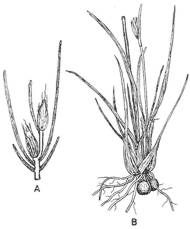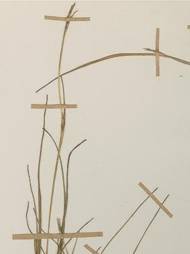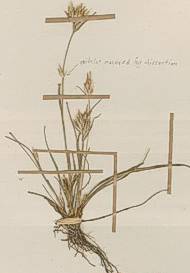Trianoptiles
Trianoptiles Fenzl.
Family: Cyperaceae
Common names: sedges (Eng.); biesies (Afr.)
Introduction
Trianoptiles is a tiny genus of three species, two of which are highly threatened in their natural habitat. Despite being on the brink of extinction in situ, Trianoptiles solitaria, the subterranean Cape sedge, is also on Australia’s Alert list of 28 Environmental Weeds.

Description
Description
All species of Trianoptiles are annuals and grow in tufts. The leaves are green, grass-like and arise in bunches. As in all Cyperaceae, the leaves have a closed sheath around the stem (known as a culm). In some species these culms or aerial flowering stems project beyond the leaves and in some species they do not.
Trianoptiles is amphicarpic i.e. it has bisexual aerial spikelets and female single-flowered partially subterranean spikelets at the base of the plant, the latter being partially hidden by the basal leaves. The subterranean fruits were originally termed bulbils. The bisexual spikelets are greenish, have three scale-like perianth segments that are hairy at the base and each terminated by three brittle bristles. It is these three bristles that give Trianoptiles its name. However, one may wonder why it was named as such, because in some cases each perianth segment may be terminated by only one bristle. The bisexual spikelets form a cyme i.e. an inflorescence in which each successive branch terminates in a flower, with the subsequent flower arising in the axil of a bract. In this case there are 3–5 bracts, the upper two with two flowers each. There are three stamens and the style has three long branches. The fruit is made up of a single carpel. The female basal spikelet produces a terminal flower subtended by 2–4 closely sheathing bracts (perianth scales absent). Most of the spikelet lies underground, with the tip of the upper bract and the style branches projecting above ground. The fruit is rounded in shape.
All species of Trianoptiles flower from August to October.
Trianoptiles is closely related to Carpha. However, the perianth of Trianoptiles is made up of three hairy scales which each have three bristles at the apex, whereas the perianth of Carpha has six bristles. Trianoptiles also differs from Carpha in that it is amphicarpic.

C. Trianoptiles capensis
a) A spikelet in the fruiting stage; b) A perianth scale; c) The early stage of development of a fruit
D. Trianoptiles solitaria
a) Spikelet bearing young fruits; b) Young fruit; c) Perianth scale
E. Trianoptiles stipitata
a) Early stage of development of a fruit; b) Perianth scale (front view); c) Perianth scale (median longitudinal section)
F. Base of T. capensis showing a young female spikelet, one of the subtending bracts removed
G. Base of T. capensis showing a female spikelet in the fruiting stage; note the axis that has appeared by intercalary growth (growth away from the central axis)
Conservation Status
Status
Trianoptiles is a genus of high conservation status. Trianoptiles solitaria is red listed as Critically Endangered owing to land degradation and population expansion. T. stipitata is listed as Data Deficient because there is insufficient information to be able to give it a red list status. It is more widespread than T. solitaria but is threatened at its localities by land degradation, agriculture and/or population expansion.
The Custodians of Rare and Endangered Wildflowers are attempting to find and monitor both species and, if successful, the Millennium Seed Bank will be notified to collect seed.
Distribution and habitat
Distribution description
All three species of Trianoptiles are restricted to the winter rainfall Cape Floristic Region, being found in damp places on flats and mountain slopes of coastal and inland regions.
Derivation of name and historical aspects
History
Trianoptiles was initially named Ecklonea in 1829 by Steudel after he described Ecklonea capensis. Steudel was unaware that Hornemann had given the name Ecklonea to a common South African seaweed just one year prior to his description of it as a Cyperaceae, and for this reason Fenzl’s new name, Trianoptiles, was adopted.
The genus Trianoptiles consists of three species, T. capensis, T. solitaria and T. stipitata, the latter two of which are highly threatened in the wild. Trianoptiles species are leafy tufted annuals, and fall within the tribe Schoeneae. They are sister to Carpha (Zhang et al. 2003). The main difference between Trianoptiles and Carpha lies in the perianth (i.e. calyx and corolla).
Ecology
Ecology
Since Trianoptiles is an amphicarpic annual (see description above), it is evoluntionarily adapted to survive under stressful conditions. Under such conditions only a basal fruit will be produced and the plant will not invest in aerial fruit. Being an annual also has its advantages, allowing the plants to set large amounts of seed when conditions are suitable.
Uses
Use
Sedges form an important component of wetlands, where they act as water purifying and erosion control agents.
Growing Trianoptiles
Grow
Trianoptiles has not been found in cultivation, although it may be worth cultivating for use in a garden setting, particularly to provide attractive green foliage around a water feature. Here it may provide depth to a display of Juncus kraussi, Aponogeton distachyos, Cyperus textilis, Chondropetalum tectorum, Isolepis prolifera and Wachendorfia thyrsiflora.
Sedges are easy to grow and very hardy. Trianoptiles can be divided by breaking apart tufts of plants. For this reason they are not commonly sown from seed. Once split, plants should be placed in a well-drained sandy mix with a good humic content. The soil should be kept damp. Trianoptiles may grow easily from seed.
Species

Trianoptiles capensis Harv.
This grass-like annual reaches 250 mm high and many of the aerial inflorescences project beyond the leaves. The greenish aerial spikelets form lax clusters on branches that arise in the axils of leaves. Most of the bisexual spikelets have five bracts and the perianth scale terminates in three bristles. The ovary is not stalked but terminates into a beak at the tip. The smoothly ribbed fruit is divided into three fused parts, the cell outlines clearly visible. The basal fruit is often found away from the central axis of the plant, as it tends to drift by intercalary growth.
T. capensis has a range extending from Ceres to the Cape Peninsula to Knysna.

Trianoptiles solitaria (C.B. Clarke) Levyns ( Subterranean Cape sedge)
A tufted annual herbaceous plant growing to 30 cm in height. The leaves arise in dense bunches and are hairless. The ligule (or membranous outgrowth at the junction of the leaf sheath and blade) is absent. The aerial flowering stems are angular to flattened and usually do not project beyond the leaves, often being found to be hidden among the leaves. They arise either singly or in pairs. The greenish spikelet is long and narrow with three bracts. The axis above the first flower is united to the second bract along the majority of its length and the second flower appears superimposed on the first. The perianth scales are linear, hairy and barely longer than the ovary. The two lateral bristles are either absent or reduced.
See more below.

Trianoptiles solitaria (C.B. Clarke) Levyns ( Subterranean Cape sedge)
The ovary is 3-angular with an almost hairless beak-like tip. The fruit is about 2 mm long with a densely pitted surface.
The basal spikelet has an extensive sheathing bract around the style. The fruits ripen in the axils of the leaves close to the stems, unlike T. capensis where some intercalary growth occurs and the fruits ripen away from the main axis of the plant. This gives a superficial resemblance to the genus of fern Isoetes.
See more below.

Trianoptiles solitaria (C.B. Clarke) Levyns ( Subterranean Cape sedge)
Interestingly enough, Subterranean Cape sedge is red listed as Critically Endangered in its local habitat, of which only fragments of natural vegetation remain on the Cape Flats, yet it is a declared weed in Australia, where it is on the Federal Government's Alert List for Environmental Weeds that was established in 2001. This is a list of weeds that currently pose more of a threat than a real problem but should be eradicated as they have the potential to cause significant damage.
(http://www.weeds.crc.org.au/documents/wmg_subterranean_cape_sedge.pdf)

Trianoptiles stipitata Levyns
Reaching 20 cm in height, this species resembles T. capensis in its growth form, although the reproductive stuctures differ slightly. It also differs from T. capensis in that its perianth scales are larger, hairier on the outer surface, and also with a tuft of hairs on the inner surface below the bristles. It has a stalked ovary, and no cell outlines are visible at the intersections of the faces.
The species has scattered collections from the Calvinia District, Vanrhynsdorp, the Cape Peninsula and Bain's Kloof, although these seem to be localised population.
References
- CRC Weed Management. 2003. Weed Management Guide: subterranean Cape Sedge, Trianoptiles solitaria. http://www.weeds.crc.org.au/documents/wmg_subterranean_cape_sedge.pdf
- Goldblatt, P. & Manning, J.C. 2000. Cape plants. A conspectus of the Cape flora of South Africa. Strelitzia 9. National Botanical Institute, Pretoria and Missouri Botanical Garden Press.
- Leistner, O.A. (ed.). 2000. Seeds plants of southern Africa : families and genera. Strelitzia 10. National Botanical Institute, Pretoria.
- Levyns, M.R. 1943. A revision of Trianoptiles Fenzl. Journal of South African Botany 26: 21-26.
- Smith, C.A. 1966. Common names of South African plants. Memoirs of the Botanical Survey of South Africa No. 35.
- Stajsic, V. & Albrecht, D. 1992. Two new introduced sedges (Cyperaceae) in Victoria. Indigenotes 5: 11.
- Trinder-Smith, T.H. 2003. The Levyns guide to the plant genera of the southwestern Cape. Contributions from the Bolus Herbarium 21 : 77-82.
- Zhang, X., Marchant, A., Wilson, K.L. & Bruhl, J.J. 2004. Phylogenetic relationships of Carpha and its relatives (Schoeneae, Cyperaceae) inferred from chloroplast trnL intron and trnL-trnF Intergenic Spacer Sequences. Molecular Phylogenetics and Evolution 31: 647-657.
- Zhang, X., Wilson, K.L. & Bruhl, J.J. 2003. Sympodial structure of spikelets in the tribe Schoeneae (Cyperaceae). American Journal of Botany 91: 24-36.
- website: www.aluka.org.
Credits
Caitlin von Witt
Custodians of Rare and Endangered Wildflowers (CREW)
July 2008
Plant Attributes:
Plant Type: Bi/Annual
SA Distribution:
Soil type:
Flowering season:
PH:
Flower colour:
Aspect:
Gardening skill:
Special Features:
Horticultural zones






Rate this article
Article well written and informative
Rate this plant
Is this an interesting plant?
Login to add your Comment
Back to topNot registered yet? Click here to register.